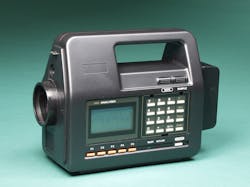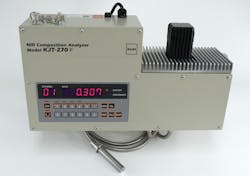Real-time NIR testing cuts cost of material quality control
By John Bogart
Managing director, Kett US
When injection molding, extruding, compounding and thermoforming plastics, it is critical to monitor processes for quality and cost at every production stage from material receipt through final inspection.
Gathering essential data can help prevent costly quality issues. Otherwise, internal production failures can require rework or result in scrap, and external failures can lead to warranty claims, recalls and even potential liability.
Globalization has put an emphasis on competing on price, quality and performance that meets very tight specifications. Measuring key production parameters effectively and efficiently is crucial to the success of the process.
While traditional testing is critical in determining factors from simple moisture content to complete chemical analysis, it is time-consuming and labor-intensive, and has substantial ongoing costs in terms of the purchase and disposal of consumables such as reagents and chemicals. Conventionally, it requires sample preparation, and can take 5 to 15 minutes for moisture testing and 24 to 48 hours for more complex chemical testing.
An approach using near-infrared (NIR) spectroscopy can provide immediate, real-time laboratory-quality readings via a non-contact, secondary measurement method that can deliver moisture or composition analysis, and even full-spectrum readings for a fraction of the running cost of conventional methods.
Real-time NIR measurement enables continuous monitoring and optimization of processes. It provides more timely quality-assurance data than a team of people using traditional testing methods and enables immediate adjustment if a process starts to drift out of the target range. Also, 100 percent of product can be inspected. The results can improve batch consistency and yield, while helping to eliminate batch failure and reduce material waste.
NIR spectroscopy bounces beams of light off a solid, slurry or liquid and measures how much light is absorbed in certain electromagnetic spectrum wavelengths (about 700 to 2,500 nanometers). This produces an “optical fingerprint” of the sample, with the device calculating the desired measurements after the device has initially been calibrated to a lab or production standard.
Despite the benefits of NIR testing, not all plastics manufacturers need to use the most sophisticated and costly devices for every application. Manufacturers do not need to pay for a more expensive full-spectrum machine if they need only moisture measurement or composition analysis, for example involving moisture and oil and/or solvent.
For many applications, a moisture meter is all that is needed. A composition analyzer is a step up; and a full-spectrum machine goes beyond that when even more comprehensive or specialized testing is required.
To help plastics manufacturers optimize quality at the lowest possible cost with NIR technology, we will examine the various options.
Choose the right equipment
NIR devices fall into two general categories: filter-based and full-spectrum.
NIR filter-based products block visible light and allow only certain wavelengths of infrared light to enter the device. Filter-based products, which include moisture meters and composition analyzers, are simpler than full-spectrum devices because they work with a limited range of wavelengths. However, the devices have some advantages.
Filter-based products are less expensive, and easier to calibrate and maintain. The devices are also more robust and typically more stable for operators to use. The drawback is that the instruments are more limited in what they can test.
Filter-based devices
Moisture meters: Traditionally, a slower method of measuring moisture is a Loss on Drying test, which measures the total material weight change after drying. Such tests typically require a sample to be prepared and brought to the lab. The test takes 15 minutes to several hours to perform, which is too slow when more immediate measurements are required. It also requires the sample to be altered or destroyed.
As an immediate, real-time alternative, NIR moisture meters are the simplest and most economical type of filter-based device. Often, NIR moisture meters are used to inspect incoming raw materials. But the meters can be used anywhere in the production process in which achieving a specific moisture content is important. With the devices, reflected light is filtered to a narrow portion of the near-infrared light spectrum, usually at only one or two wavelengths.
Composition analyzers:Among filter-based devices, NIR composition analyzers are a step up in measuring capability, and usually can simultaneously measure a few chemical components in the polymer while being limited to about six to seven wavelengths of light. In addition to moisture, the devices also can be used to measure residual oils or solvents, which can cause contamination issues if not detected and removed.Users of composition analyzers can include companies that use recycled plastic. Because they might not always know the origin of the material, they might want to measure total oil and solvent in addition to moisture, since any residual contaminants can disrupt the process and even cause a plant malfunction.
Another use of this type of device is to measure film thickness. Both desktop and real-time online process measurements can be provided in many cases. Generally, the price of the NIR composition analyzer is substantially lower than alternative technologies.
A third traditional use of this type of device involves solution polymerization, which is conducted with an inert solvent and initiator. An NIR composition analyzer can be helpful for monitoring and adjusting the process.
Because polymers are so widely used in a variety of industries, composition analyzers are often used not only on incoming materials, but also on in-process materials, final products, and even on external product failures and returns to help determine the cause of the problem.
Full-spectrum devices
In contrast to filter-based devices, NIR full-spectrum devices can measure 500-plus wavelengths to determine if certain substances or materials meet a wide range of criteria.
With full-spectrum testing, the widest number of targeted factors can be measured in real time, once the device is specifically calibrated for their detection. In addition to moisture, for example, polymer manufacturers can often measure density, viscosity, melt flow rate (MFR) and functional groups.
Such testing is common during emulsion polymerization, which is used to produce latexes and synthetic polymer colloids for paint, coating, rubber, binder and adhesive applications.
The testing also is helpful for successfully carrying out suspension polymerization processes, which are often used to produce polymer beads. Such processes generally involve an initiator and co-monomers, with the final polymers suspended in an aqueous phase containing additives and residual monomer.
For quality control, manufacturers might need to monitor many chemical reactions during the polymerization process to bring it to the desired end. For instance, several chemicals might cause a reaction that transforms them into a blended product. In such cases, manufacturers can optimize the quality and speed of their process with NIR full-spectrum testing to ensure that everything produced is a completely finished product with no residual chemicals left over.
While plastics manufacturers are more familiar with traditional methods, for those concerned not only with quality but also profitability, selecting the NIR approach that works best for the application — whether moisture meter, composition analyzer or full-spectrum tester — can have a major impact on the bottom line.
Contact:
Kett US, Villa Park, Calif., 800-438-5388, [email protected], www.kett.com



